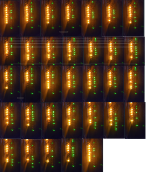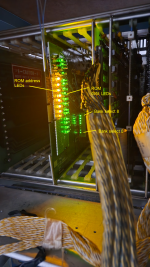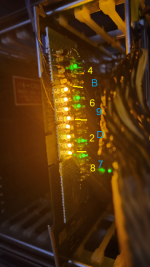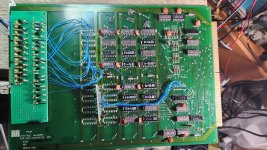Upcoming Events:
| VCF West | Aug 01 - 02 2025, | CHM, Mountain View, CA |
| VCF Midwest | Sep 13 - 14 2025, | Schaumburg, IL |
| VCF Montreal | Jan 24 - 25, 2026, | RMC Saint Jean, Montreal, Canada |
| VCF SoCal | Feb 14 - 15, 2026, | Hotel Fera, Orange CA |
| VCF Southwest | May 29 - 31, 2026, | Westin Dallas Fort Worth Airport |
| VCF Southeast | June, 2026 | Atlanta, GA |
-
Please review our updated Terms and Rules here
You are using an out of date browser. It may not display this or other websites correctly.
You should upgrade or use an alternative browser.
You should upgrade or use an alternative browser.
MAI Basic Four BB1 64K FERRITE CORE MEMORY BOARDS
- Thread starter evanderryd
- Start date
I'm replying here to my own post. I have an important announcement - I now have a fully-working Microdata 1600!
Since I don't have a service panel, only the minimal one, with two lights and a few switches, I wasn't able to look into the machine and figure out how to get ot to boot up after 40 years of its having sat in a dark basement, gathering dust and deceased arachnids.
Well, so I built some test equipment into the machine, as you'll see and then single-stepped through the microcode in the ROMs. I then had to interpret what I saw and...well you'll see all that below and in the attached photos:
Since I don't have a service panel, only the minimal one, with two lights and a few switches, I wasn't able to look into the machine and figure out how to get ot to boot up after 40 years of its having sat in a dark basement, gathering dust and deceased arachnids.
Well, so I built some test equipment into the machine, as you'll see and then single-stepped through the microcode in the ROMs. I then had to interpret what I saw and...well you'll see all that below and in the attached photos:
Attachments
Our motto in Latin when I served n the RAF was "Per ardua ad astra", meaning through struggle to the stars..
well this issue on the Microdata machine certainly provided plenty of ardua but I was eventually rewarded with a trip to the astra!
This is how to get control of a beast like this one if you don't have a service panel. I'm tempted to leave these LEDs on the ROM board permanently, since each individual LED is driven by a transistor that presents a minimal load to each bus line - and this way I can always see what microcode the machine is currently executing.
well this issue on the Microdata machine certainly provided plenty of ardua but I was eventually rewarded with a trip to the astra!
This is how to get control of a beast like this one if you don't have a service panel. I'm tempted to leave these LEDs on the ROM board permanently, since each individual LED is driven by a transistor that presents a minimal load to each bus line - and this way I can always see what microcode the machine is currently executing.
That first instruction that you can see in the green LEDs (the top one is the most significant bit)– you have to read each nibble in reverse, so it’s 1462 – that’s a microcode instruction to jump forward 96 locations. It didn't do that and was thus doomed to failure.
I figured out that the machine was scanning through the ROM addresses but never actually executing any of the resulting instructions appearing on the 16 data lines.
I figured out that the machine was scanning through the ROM addresses but never actually executing any of the resulting instructions appearing on the 16 data lines.
I stepped through about 80-100 instructions using the front panel's Clock switch, Then I brought it into a video editor and I slowed it down and wrote down the 16-bit data words and try to interpret them.
That's what I did yesterday. So far, though, the instructions were displayed but not being executed.
What I noticed is that, interestingly, each word needs to be read backwards in order to make sense.
15 14 13 12 11 10 9 8 7 6 5 4 3 2 1 0
0 0 1 0 0 1 1 0 0 1 0 0 0 0 0 1
2641
If you read it as 1462 then it's a jump instruction
Jump instructions begin with 14/15/1C/1D
So...the very first instruction placed on the 16 output data bits of the ROM board when you press Reset
is 1462, which means jump to location 62 in the current ROM memory Bank. Great! ...except that it's not doing that jump - just stupidly continuing to read the next data word etc etc etc. So I KNOW it's stuck in a diagnostic Scan Mode. If I fix that then the machine should just run properly.
That's what I did yesterday. So far, though, the instructions were displayed but not being executed.
What I noticed is that, interestingly, each word needs to be read backwards in order to make sense.
15 14 13 12 11 10 9 8 7 6 5 4 3 2 1 0
0 0 1 0 0 1 1 0 0 1 0 0 0 0 0 1
2641
If you read it as 1462 then it's a jump instruction
Jump instructions begin with 14/15/1C/1D
So...the very first instruction placed on the 16 output data bits of the ROM board when you press Reset
is 1462, which means jump to location 62 in the current ROM memory Bank. Great! ...except that it's not doing that jump - just stupidly continuing to read the next data word etc etc etc. So I KNOW it's stuck in a diagnostic Scan Mode. If I fix that then the machine should just run properly.
OK, what Scan Mode does is stop the output of the lower 8 bits of the command words coming from the ROM data bus from making it into the R register, which is what the processor executes every time it sees a new command arrive. SO the processor is blissfully unaware of any of this going on.
It was a nasty little problem, with far-reaching consequences.
Scan Mode is something that you can switch the machine into, using a switch on the Service Panel - I don't have that panel - my machine has the basic, user panel instead, only two lights and a few switches - enough to simply startup and shut down the computer, nothing more.
Without the Service panel that Scan Mode line is normally pulled high (inactive) by a 470 ohm resistor. Well that resistor was open-circuit!! It looks perfect from the outside. How unusual - I've never encountered that problem, across all the many thousands of boards I've diagnosed in my life. I found it by using my LED test setup and carefully observing what was going on.
It was a nasty little problem, with far-reaching consequences.
Scan Mode is something that you can switch the machine into, using a switch on the Service Panel - I don't have that panel - my machine has the basic, user panel instead, only two lights and a few switches - enough to simply startup and shut down the computer, nothing more.
Without the Service panel that Scan Mode line is normally pulled high (inactive) by a 470 ohm resistor. Well that resistor was open-circuit!! It looks perfect from the outside. How unusual - I've never encountered that problem, across all the many thousands of boards I've diagnosed in my life. I found it by using my LED test setup and carefully observing what was going on.
I now feel very confident about working right down onto the boards and to each logic device that comprise this computer, having developed a deep understanding of how it all works. It's a virtual machine, built upon the combination of firmware and Boolean logic they call microcode. I find it more interesting even than working with today's Atmel processors - and those are terrific fun too. ....but this is the top of the tree, as far as I'm concerned!
It presents itself, to an assembler programmer, as a simple, PDP-11-like or Motorola 6800-like machine, having a simple architecture: two 16-bit accumulators, A and B and X, which is a 16-bit Index register. Go read the instruction set card fir the Motorola 6809, for example and it closely resembles those that are available on this emulated machine. Underneath that set of simple instructions is the microcode, consisting of instructions whose bits pull and push 0 or 1 onto wires connected to actual logic gates down on the two boards that comprise the computer. Sets of 3 or 4's of those wires go into decoders that use the binary combination of those 3 or 4 wires to select one of 16 output lines and each of those is labeled with the actual opcode names in the microcode programming handbook. ..........and that's how this type of machine works. The same goes for all those early-mid-70's minicomputers.
It presents itself, to an assembler programmer, as a simple, PDP-11-like or Motorola 6800-like machine, having a simple architecture: two 16-bit accumulators, A and B and X, which is a 16-bit Index register. Go read the instruction set card fir the Motorola 6809, for example and it closely resembles those that are available on this emulated machine. Underneath that set of simple instructions is the microcode, consisting of instructions whose bits pull and push 0 or 1 onto wires connected to actual logic gates down on the two boards that comprise the computer. Sets of 3 or 4's of those wires go into decoders that use the binary combination of those 3 or 4 wires to select one of 16 output lines and each of those is labeled with the actual opcode names in the microcode programming handbook. ..........and that's how this type of machine works. The same goes for all those early-mid-70's minicomputers.
....but don't for a moment think that these aren't powerful computers, as simplistic as they might appear to be. One of these with only 16k of memory and a 5MB hard drive will run the accounting, inventory scheduling, payroll etc etc etc for en entire company and four or eight users can use it simultaneously. In their Basic Four guise, as the Basic Four model 1200, thousands of these ran hotel chains, public warehouses, hospitals, manufacturers, lumber mills and hundreds of other types of businesses. What triggered their being phased out was a perceived advantage to having PCs installed instead of dumb terminals, in order to distribute the processing load.
Well, to close out here, there is now a fully-functioning real Microdata 1600 on the West Coast. I intend putting it to work. It's capable of controlling processes too. Hmmm I've watched a few Wallace and Gromit films and rather fancy the idea of waking up to fresh coffee already made and the prospect of watching jam fly across the room to land perfectly on toast as it pops out of the toaster!
Jeremy MacDonald
Well, to close out here, there is now a fully-functioning real Microdata 1600 on the West Coast. I intend putting it to work. It's capable of controlling processes too. Hmmm I've watched a few Wallace and Gromit films and rather fancy the idea of waking up to fresh coffee already made and the prospect of watching jam fly across the room to land perfectly on toast as it pops out of the toaster!
Jeremy MacDonald




